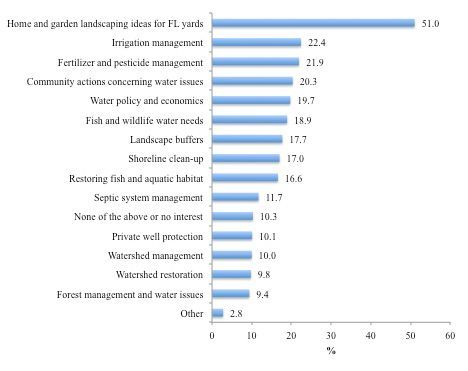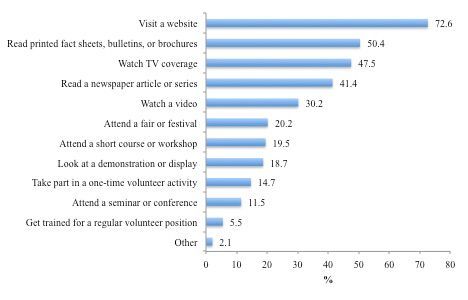Introduction
Florida is well known for its plentiful water resources. Its residents are also known for consuming large amounts of water for landscape irrigation (Marella, 2013; South Florida Water Management District, 2008). Water resources have become limited in Florida; therefore, sustaining water resources is critical so that each sector of the state, from individual residents to industries, can have safe and secure water resources. In order to enhance public engagement in water conservation, effective communication is necessary to facilitate knowledge gain, idea-sharing, and information distribution (King & Rollins, 1995; Leeuwis, 2008).
Homeowners who use excessive amounts of water to irrigate their landscapes have specific demographic characteristics and behavioral patterns and have been identified as high water users (Huang, Lamm, & Dukes, 2016; Monaghan, Ott, Wilber, Gouldthorpe, & Racevskis, 2013). While previous research revealed difficulties in engaging high water users in water conservation (Israel & Knox, 2013), more understanding about high water users' learning interests and use of information sources may reduce the difficulties in educating high water users about water conservation. This EDIS document is the third in a series discussing how Extension can improve high water users' engagement in water conservation, focusing on how to effectively communicate with high water users about water conservation education. The entire series includes the following EDIS documents:
- High Water Users' Experiences and Perceptions of Water (https://edis.ifas.ufl.edu/publication/WC255)
- High Water Users' Water-Related Behaviors and Willingness to Act (https://edis.ifas.ufl.edu/publication/WC256)
- High Water Users' Opportunities to Learn about Water Conservation (https://edis.ifas.ufl.edu/publication/WC257)
High water users in Florida tend to hire contractors for landscape management rather than managing their own landscapes (Davis & Dukes, 2014; Huang et al., 2016). Generally, they live in neighborhoods with a homeowners association (HOA), are older than the average resident, have a higher income level than the average resident, and have obtained a higher level of education than the average resident (Huang et al., 2016; Monaghan et al., 2013).
To examine the best ways to reach high water users, an online survey was developed to collect their opinions. The survey was administered electronically to Florida high water users living in the Orlando area (N = 512), Tampa/Sarasota area (N = 219), and Miami/Fort Lauderdale area (N = 201). In total, 3,494 individuals were invited as respondents of the survey, and 932 complete responses were received (27% participation rate). Detailed demographics of the high water user respondents in this study can be found in the first EDIS document of the series: https://edis.ifas.ufl.edu/publication/WC255.
Topics of Interest
High water users were asked to indicate the water-related topics they would like to learn more about. The results of high water users' water topics of interest are displayed in Figure 1. High water users were most interested in the topics related to landscape management. The water topic of most interest was "Home and garden landscaping ideas for Florida yards." In addition, 22% of high water users were interested in learning more about irrigation, fertilizer, and pesticide management. Respondents were least interested in learning about forest management, watershed restoration, and watershed management.

Credit:
Preferred Learning Channels
High water users were also asked to indicate the learning channel they prefer to use when learning about water topics. Specifics regarding preferred learning channels can be seen in Figure 2. High water users preferred to use websites (73%), followed by printed fact sheets, bulletins, or brochures (50%) and television (48%). Only 6% of high-water users would like to get trained for a regular volunteer position to learn about water-related topics.

Credit:
Discussion
High water users showed specific interests in learning about water information related to landscaping management. As for preferred learning channels, high water users preferred to learn about water through one-directional channels, particularly websites and other traditional communication channels (e.g., printed materials, television, and newspaper), rather than through channels needing physical attendance.
To enhance communication effectiveness with high water users, Extension educators should take their topics of interest and preferred learning channels into consideration when developing and implementing educational programs and communication campaigns. Since high water users are particularly interested in information related to landscape management, Extension educators should emphasize water-conservation information and recommendations related to landscape management with this audience via websites, printed materials, television, and newspaper, which are the learning channels they prefer to use. Extension educators should additionally make efforts to provide guidance to high water users on how to properly look for trustworthy online information tailored to their needs. By developing and implementing educational programs based on the preferences of this target audience, high water users can be reached with the potential for behavior change (King & Rollins, 1995; Leeuwis, 2008). Since high water users consume excessive amounts of water, they have the most room for improvement and, therefore, the impact on overall water conservation is expected to be high.
References
Davis, S. L., & Dukes, M. D. (2014). Methodologies for successful implementation of smart irrigation controllers. Journal of Irrigation and Drainage Engineering. Retrieved from https://ascelibrary.org/doi/pdf/10.1061/%28ASCE%29IR.1943-4774.0000804
Huang, P., Lamm, A. J., & Dukes, M. (2016). Informing extension program development through audience segmentation: Targeting high water users. Journal of Agricultural Education, 57(2), 60–74. doi: 10.5032/jae.2016.02060
Israel, G. D., & Knox, G. W. (2010). Reaching diverse homeowner audiences with environmental landscape programs: Comparing lawn service users and nonusers. AEC363. Gainesville: University of Florida Institute of Food and Agricultural Sciences. (No longer available online.)
King, R. N., & Rollins, T. (1995). Factors influencing the adoption decision: An analysis of adopters and nonadopters. Journal of Agricultural Education, 36(4), 39–47. doi:10.5032/jae.1995.04039
Leeuwis, C. (2008). Communication for rural innovation: Rethinking agricultural extension. Oxford, UK: Blackwell Science Ltd.
Marella, R. (2013). Water use in Florida, 2005 and trends 1950–2005. U.S. Geological Survey. Retrieved from https://pubs.usgs.gov/fs/2008/3080/
Monaghan, P., Ott, E., Wilber, W., Gouldthorpe, J., & Racevskis, L. (2013). Defining audience segments for extension programming using reported water conservation practices. Journal of Extension, 51(6). Retrieved from https://tigerprints.clemson.edu/joe/vol51/iss6/8/
South Florida Water Management District. (2008). Water conservation: A comprehensive program for South Florida. Retrieved from https://www.sfwmd.gov/sites/default/files/documents/waterconservationplan.pdf